FeministTech
Feminist-tech Design
Narratives of Empowerment
Abstract
The hormonal contraceptive pill was introduced as a means to control and regulate the reproductive nature of women. It quickly became a symbol for empowerment and sexual liberation. However, an alternative reality behind the use and prescription of the pill, beyond its initial intention as contraception, has transformed the pill into a method of control - backtracking on its initial promises. This, I argue, is only accelerated with the rise of Female Health Technologies.
This thesis analyzes the design of the pill and its related digital technologies to challenge the notion of empowerment, by revealing the underlying narratives conveyed through employed design strategies and techniques. Accordingly, this thesis demonstrates that a continued system of power and control over the female body exists under the pretense of empowerment and notions of “normal”. Furthermore, within the space of digital technologies, the shift in control from a top-down power structure to an internalised process of self-tracking and self-surveillance is explored. Based on these ideas, a Cyberfeminist approach is used to challenge the power dynamics perpetuated by technology. In the process, this thesis advocates the need for a redesign of these technologies, which holds true to the promise of empowerment.
Alongside the research of leading authors in the field of Feminism and Female Health Technologies, I drew on my personal experience to offer foundational evidence against theoretical findings. Additionally, by prioritising alternative forms of knowledge, this thesis drew on the work of Clarissa Pinkola Estés. Inspired by this author, I chose to document lived experiences through feminist autobiographic writing.
Introduction
As a method to control and regulate the reproductive nature of women, the hormonal contraceptive pill (the pill) offered women the space to decide for and about their own bodies. Through this, the pill became a symbol for empowerment and sexual liberation (Bridge, 2007). However, an alternative reality exists behind the use and prescription of the pill, beyond its initial intention as contraception.
The ideas of empowerment that are connected to the pill have been an illusion for many: Submission framed as choice, self-surveillance as self-care, authoritarian regime as self-discipline, and the alienation from body and mind framed as natural.
My urgency to explore this topic rests in my own experiences over the last decade, where I have been situated between medical professionals, digital technologies and (gendered) societal structures. Since I approach this subject from two perspectives, first as a woman, and second as a designer 1 , I find it important to weave together the knowledge from both to offer a more comprehensive understanding of the issue's multi-faceted nature.
Thus, this thesis intertwines lived experiences in the form of feminist autobiographic writings 2 , termed ‘anecdotal accounts’, to retain a level of feminist objectivity (Haraway, 1988). These accounts are offered as evidence alongside theoretical findings and stand as a method to provide support for the urgency with which I approach this thesis. However, it must be emphasized that my individualized lived experience cannot, and should not, stand as a poster child for the experiences of all.
It has been through the act of sharing experiences that I have discovered the stories of others. Some of which share my rage, others who can see and understand its origin, and few that do not identify with it at all. Is it not the collection of these stories that allow for a better understanding of the lived reality of women? A reality which, I argue, has been largely discredited and overlooked.
The discreditation of lived experiences has been met with the development of Female Health Technologies (Femtech) which markets itself as a tool of empowerment. This thesis argues that the narrative of empowerment employed by Femtech regrettably relies on an internalized processes of self-tracking and self-surveillance. To prove this, the design language of the pill and its related digital technologies will be investigated below, using a visual analysis to document the ways in which the symbolic power of empowerment has entered an arena of exploitive behavior.
Based on these ideas, a Cyberfeminist 3 approach is used to challenge the power dynamics perpetuated by technology and to deconstruct the implications of this on issues of gender and identity. In the process, this thesis advocates the need for a re-imagination of the design of these technologies, which holds true to the promise of empowerment.
The process of re-imagining a Feminist-Tech, however, is not a new one. There is a plethora of collectives, communities and initiatives working towards constructing a fair, equitable and just cyberspace. The design and tactics of these Femtech applications (apps), exemplifying how Femtech can be used as an instrument for empowerment, will be explored, in order to highlight the potential for Femtech to not only improve women's health and wellness, but to additionally contribute to a feminist future. Drawing on this, this thesis offers additional insights that can be interjected into the broader discourse surrounding Feminist-tech.
Interjection
Anecdotal account
I remember waking up in the middle of the night to excruciating stomach pain. Although the pain had made its home in my body for quite a while, the severity reached its peak. Naturally, my parents rushed me to the emergency room. After what felt like hours of medical examinations, which came back as inconclusive, a nurse suggested to my mother that I see a gynechologist, based on her assumption that I had a bad case of PMS (Premenstrual Syndrome).
The following decade saw a religious cycle of starting the pill, side effects, changing the pill, side effects, surgery, pill, side effects, pill. The prescription of the pill promised a life without pain.
This moment marked the beginning of my journey with the hormonal contraceptive pill, which ironically began without the need for contraception. I was told that in order to live a life without pain, I would have to take the pill.
A deception to say the least.
The Pill
“Consume a pill and take control of your life.” (Woods, 2013)
The birth of the hormonal contraceptive pill (the pill) in the 1950s saw the onset of the liberation of female sexuality (Bridge, 2007). The pill falls within the women’s suffrage movement of the 20th century which followed the initiatives of Margaret Sanger, the co-creator of the pill, in what has been deemed an “organized fight for contraception” (Todd, 2018).
The hormones in the pill prevent ovulation; without ovulation, there is no chance for pregnancy (Johnson, 2020). Alongside the capacity for women to rid themselves of their bestowed categorization as ‘baby-makers’, they were able to decide for and about their own bodies. Thus, the pill played an important role in the breakdown of gendered norms and stereotypes. Ultimately, the capacity to control the body, in this way, became an agent of empowerment (Todd, 2018).
Initially, the lack of a monthly period was considered “unnatural”. This added to the hesitations surrounding the pill upon its first invention (Todd, 2018). To counter this, a five-day break (every 21 days) was recommended, introducing “...a ‘fake period’ into the oral contraceptive regimen” (Woods, 2013). The popularity of the pill grew, as it was not only promoted as a method of regulating menstruation, but additionally prevented pregnancy almost 100% effectively.
However, the efficacy of the pill for contraceptive purposes relies on its daily consumption. The five-day break disrupts this rhythm which caused many women to lose track of when to take the pill. At the time, the pill came packaged like most medications: a brown bottle with an industry standard label (Fig.1). The standardized packaging only added to the difficulty of remembering to take the pill. The solution to this problem was approached through the design of the pill’s packaging (Johnson, 2020).

The re-design of the brown bottle begins with a woman, Doris Wagner, who began taking the pill in 1961, and ends with a man, her husband, David. P Wagner (Johnson, 2020). According to the National Museum of American History (n, d.), “Wagner was prompted to invent the device when he and his wife had trouble remembering if she had taken her daily pill.” Wagner sketched a calendar on a piece of paper, placing the individual pills on the correct spot to “…help Doris keep track” (Johnson, 2020).
This led him to design a pill dispenser with an imbedded calendar system. The patent, (Fig. 2) and prototypes (Fig. 3) show the design which aimed at assisting women who had difficulty in remembering to take the pill. Additionally, the design offered a level of discreteness since it came disguised as make-up compact (Fig 4.).
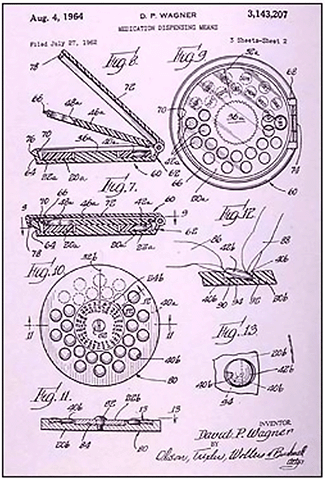

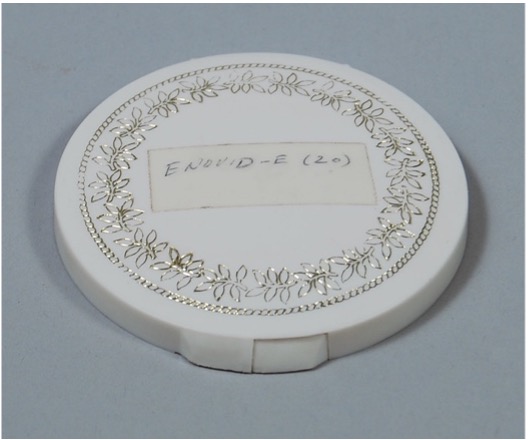
The DialPak, introduced in 1963, was the first oral contraceptive package to incorporate a ‘memory aid’ following Wagner’s patent. The DialPak was advertised as “the package that remembers for her” to differentiate itself from competing brands (National Museum of American History, n.d.). One advertisement (Fig 5.) not only promoted the ‘memory aid’, but also a watchstrap calendar with the phrase “For her…For you”. The watch gave men the ability to wear their partner’s cycle calendar on their wrists to always have the important dates “on-hand” (“The Pill: Gallery | American Experience | PBS,” 2020).
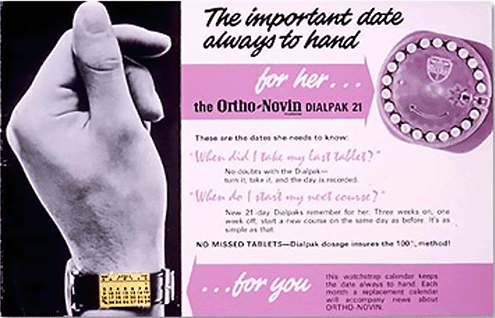
Following the DialPak “…all oral contraceptives would be packaged in memory-aid dispensers” (National Museum of American History, n.d.). Organon, the manufacturer of ‘Desogen’, released the ‘Starter Kit for Forgetful Women’ (Fig. 6) in 1993. The kit included “a bar of soap, a toothbrush, and a ‘Remember Me’ sticker with the slogan, ‘Wash your face, brush your teeth, take your pill, once a day, every day, at the same time’” (“The Pill: Gallery | American Experience | PBS,” 2020). Thus, the rhetoric of the ‘forgetful woman’ developed into an industry standard in the packaging design of the pill.

Since the 1990s, the design of the pill’s packaging has shown little innovation. The most noticeable difference, however, is the step away from the elaborate designs of the compact-mirror casing to a more rigid and strict design of the pill strip (Fig. 7). With this, the focus of the packaging centred around the memory aid. The memory aid, presented through small black arrows (Fig. 8), creates a directional flow evoking an order in which the pills are to be taken. The design language of the instructional arrows adds to the strict design of the pill strip which subtly suggests a sense of uniformity and conformity.

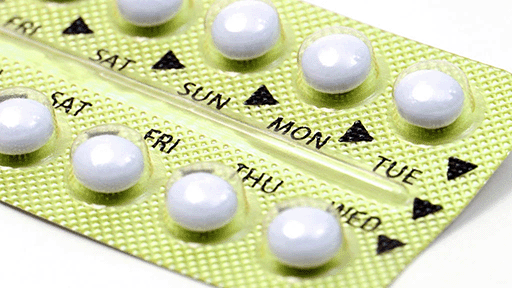
Additionally, the design of the 28-day pack, with its memory aid ‘remembering for her’ and color-coded system of placebo pills (Fig, 9.) has the potential to make the act of taking the pill a less conscious process. Since the seven placebo pills function to remove the five-day break, compliance with a daily regime is ensured. On one hand this makes it easier for women to remember to take their pills, but on the other, it undermines their autonomy and agency. The design of the packaging thus serves as a method of domestication, transforming the action of taking the pill to less of an active decision, enforcing coherence to a strict regime.
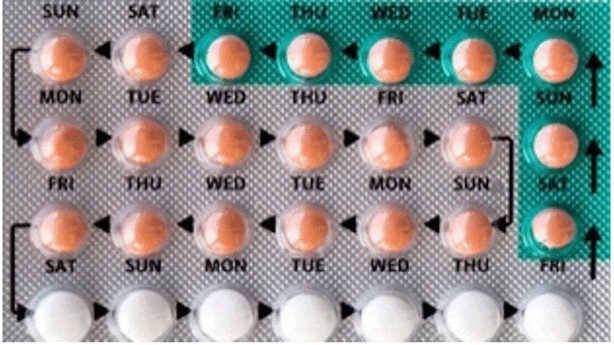
What began as taking one pill out of a brown bottle once a day, developed into a routinized schedule, designed in such a way that it allowed for the monitoring, not only by women, as seen in the example of the “Starter Kit for Forgetful Women”, but also by the watchful eyes of husbands and society. The pill, through the redesign of its packaging (which ranged in shades of pink, majestical serif fonts and disguised as a make-up compacts), suddenly made its way into the realm of gendered stereotypes and norms - a clause in the contraceptive contract feminists would surely veto.
Furthermore, the inbred calendar system “naturally” synchronizes with the menstrual cycle (National Museum of American History, n.d.). This created the capacity for menstruation to be artificially visualized. Enabling women not only to remember to take their pills, but additionally offering visual cues signaling when menstruation would occur. Thus, the redesign of the pill has since provided further means to “track” the menstruating capacity of women. This, met with routinized taking of the pill, developed the grounds on which the female body entered the space of regime and control in a profoundly new capacity.
Side Primary Effects
Rachael Kay Eastham (2016) argues in her Ph.D. thesis, ‘Negotiating the Fertile body: Women’s life history experiences of using contraception’, that it is necessary to look at the body as a site for notions of control. She suggests that the body exists in two states: contracepting and non-contracepting. This resonates with the thought of mind/body separation, which is similarly brought forth by Clarissa Pinkola Estés (1992) in her Ph.D. thesis, “Women Who Run with the Wolves: Myths and Stories of the Wild Woman Archetype”. Estés explains that a “…woman is born with all instinct intact” (Estés, pg. 249, 1992), however, warns that these instincts can become severed. With that, she argues, women begin to live in a “semi-destroyed state” (Estés, pg. 8, 1992).
Eastham explains that this severance arises through two interconnected levels: firstly, through the side effects experienced and secondly, between women and the institutions surrounding the pill that normalize these experiences.
The categorizations of the contracepting body as “normal” devalues the lived experiences of women. This results in ‘contraceptive dysphoria’ which Eastham outlines as “…a holistic experience resulting in distress, confusion, or anxiety about a perceived disconnection from the ‘normal’ self” (Eastham, pg. 232, 2016). Eastham argues that the lived experience of women is as 'real' (if not more so) than the data drawn on by clinicians to legitimize or discredit contraceptive side effects.
The discreditation of lived experience stems from a broader issue which is grounded in the deficiency of research surrounding the pill. More specifically, “there are few studies on [the]side effects or long-term effects [of the pill].” This is largely due to two reasons, as told by physicians: “the lack of incentives to explore a drug that is widely known to be safe, and the difficulty of such studies” (Cravatts, 2021).
Adding to this, the label "side effects" minimizes women's experiences, stripping away their individual agency. This is reiterated by Estés in her statement that an "instinct-injured woman has no choice" (Estés, pg. 250, 1992). It is important to acknowledge that these experiences are not just side effects, but primary experiences for many women. As a result, an increasing number of disenchanted women have begun to look beyond the pill, for alternative non-hormonal options that will reinstate their sense of control, choice, and sanity.
Interjection
Anecdotal Account
Since being prescribed the pill at the age of fourteen, I have been on four different brands of pills. With each pill came a new list of side effects. However, the risk of side effects was masked by a constant reiteration that the pill was the only solution to managing my body.
Overtime, it felt like a scary game of “Spin the Wheel” and see what side effects you’ll get: debilitating period pain, acne, chronic bloating, fatigue, extreme burst of anger, depression, anxiety, brain fog - to name a few. Along with this, an increasing cut between my mind and body over the last ten years resulted in body dysmorphia.
When confronting my doctor each time with the list of side effects that were impacting my life, relationships, and well-being, I was told “not to worry about it” and that it was “normal”. I felt hopeless and unheard - breaking down after each appointment. All I wanted was for someone to acknowledge the hell I was living, and to help me get out of it.
Beyond the Pill: Femtech
The growing need to find alternative options beyond the pill has been met with the ever-increasing digitalization of the world. Female Health Technologies (Femtech) 4 have burst onto the scene offering a range of devices and mobile applications (app/s) to manage and monitor female health, including reproductive health.
Femtech is a response to the “the scarcity of research dedicated to women’s health” (Welkin, 2022). Although a relatively new field, Femtech has positioned itself as having a “…pivotal role in creating a space for women’s wellness” as well as “…giving women more power over their health” (Welkin, 2022). The rhetoric of empowering women by enabling them to take their health into their own hands is at the heart of this industry. Followed by neoliberal ideas of autonomy, Femtech promotes itself as self-care tech with a female-centered approach.
The success of Femtech, which expects a market gain of $3 billion by 2030 (Welkin, 2022), is an indicator of the legitimate need for female-centered technology that makes health care accessible and inclusive. The awareness of this need correlates to the boom of Femtech start-ups since 2021 (Welkin, 2022). One start-up making waves is ‘Natural Cycles’, the first FDA (U.S. Food and Drug Administration) cleared birth control app. Initially developed by Elina Berglund as a method to track her own fertility in 2013, Natural Cycles (NC) has since gained 2.5 million registered users (Natural Cycles, 2020).
Natural Cycles stands as the digital counterpart to the pill in cyberspace. Marketed as the “hormone-free” app that is “tailored to you” and “side-effect-free” (Natural Cycles, 2020), NC hits all the sweet spots for women looking for an alternative to hormonal contraceptive methods.
Upon subscribing to NC users receive a thermometer kit presented as the start to their self-discovery journey (Fig. 10). Based off the daily input of the user’s body temperature (Fig. 11), the app uses an algorithm that “learns the pattern of your unique cycle” (Natural Cycles, 2020). This information is used to map and predict ovulation in real-time, to notify users when they are fertile, termed “red days”, (Fig. 12), and not fertile, termed “green days” (Fig. 13) (Lundin, 2017).

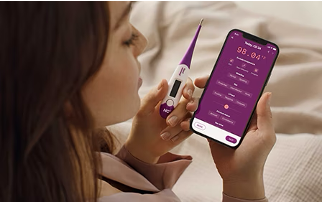

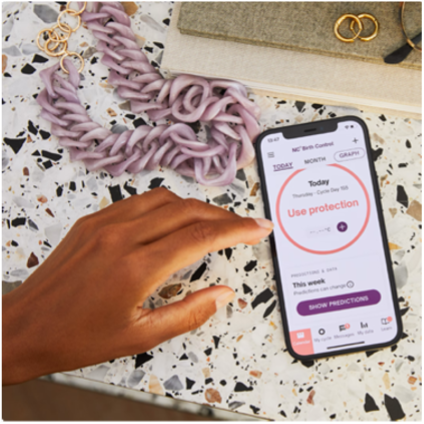
Along with the daily inputting of body temperature, the app provides features to log all “symptoms” and changes experienced during the menstrual cycle. The logged data is visualized so that patterns are detectable. This is promoted as a means to understand and learn about the user’s cycle. Through this, users are promised an increased capacity for control over their own bodies as they ‘get to know themselves better’.
Interjection
Anecdotal Account
There came a time when the decision to go off the pill lingered in the back of my mind. While one would assume that the decision would be jumped at, if indeed my experiences were so brutal, it was a rather tricky scenario to decide upon:
There was little comfort provided as the pill’s alternatives were pushed onto me as “not as effective” or “unreliable”. I began to question whether it was okay to live with such severe side effects…rather than finding an alternative approach.
Naturally, the side effects of being on the pill won and I faced a situation where I saw myself forced to either get off the pill, or it would swallow me whole. Through social media, I discovered that many women were using apps for contraception and period tracking, ditching hormones in a movement called “hormone-free”.
Key to the marketing strategy of NC is its social media presence. With 424K followers 5, their platform centers around building a (growing) community. This is achieved through targeted advertising that uses sponsored influencers “telling you how it changed their lives” (Sudjic, 2018). To underpin this, NC uses its own language: “users are known as ‘Cyclers’, [(Fig. 16)] and useful information is available via a ‘Cyclerpedia’” (Sudjic, 2018). The ‘Cycler’ is used as a tool to promote the rhetoric of empowerment through an increased capacity of self-awareness and body autonomy that is ‘only’ achievable through the app (Fig. 17).
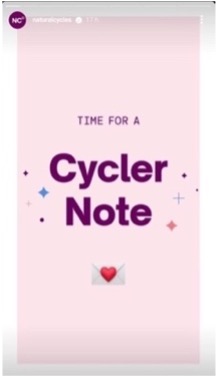
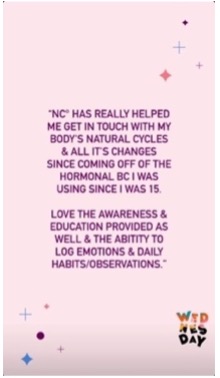
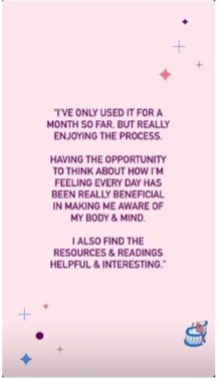

The ‘Cycler’, although promoted as a liberal free-thinking woman who has regained her sense of empowerment, is in fact a “narrow, rather old-fashioned category of person” (Sudjic, 2018). According to Elina Berglund, the ideal Cycler is “in a stable relationship with a stable lifestyle” (Sudjic, 2018). Berglund emphasizes that the app is not suited for someone who has an “irregular lifestyle, irregular menstrual cycles or lacks the motivation to stay on top of their cycles” (Lundin, 2017). If this is the case, to whom does empowerment belong? Is empowerment only accessible to women in their late 20s who’s menstrual cycle matches their perfectly organized, routinized life? The narrative of empowerment thus deserves scrutiny.
Interjection
Anecdotal Account
It seemed like my social media algorithm knew that I was looking to go “hormone-free”. I was bombarded with stories and posts that read, “My mood when I can use natural cycles instead of putting hormones in my body…” (Fig. 14) and “As the years go by, I have a deeper appreciation for my body…to make the right decisions for my body, knowledge truly is power…” (Fig. 15). They all gloated about how, through the use of these apps, they were able to track their cycle and log their daily symptoms to help them do what was needed to finally feel “normal”.

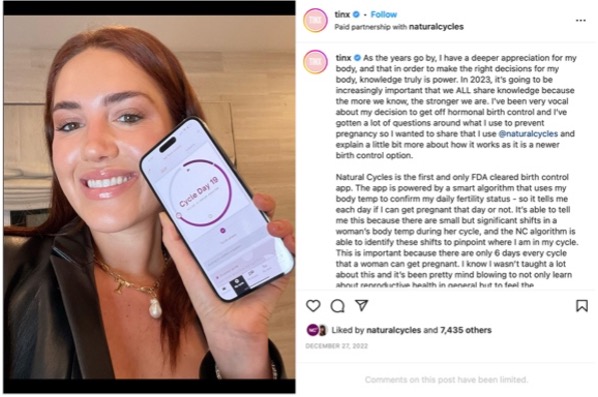
The Gilded Cage
In her writing, ‘Feminism and Empowerment: A Critical Reading of Foucault’, Monique Deveaux (1994) explores the notions of power within the feminist scope. Deveaux explains that the “transition from sovereign, or monarchical, power to modern regulatory power [is] comprised of disciplinary regimes, systems of surveillance, and normalizing tactics…” (Deveaux, pg.224, 1994). The shift to modern regulatory power gives an insight into the construction of power. This will be used to build an argument for the ways in which power is disseminated through Femtech:
The analysis of power begins with examining disciplinary regimes. In the context of Femtech, disciplinary regimes are established through designed gamification techniques that enforce internalized devotion. These techniques reward users for inputting menstrual data and encourage continued use through positive reinforcement systems, such as ‘streak’ functions which elicit a ‘feel-good’ response (Fig. 20, Fig. 21, Fig. 22). With this, users are domesticated as these technologies increasingly become incorporated into daily routines (Lupton, 2013).



Femtech uses chat-like functions to reinforce compliance with the app’s norms and standards. The language used is strict and governing yet presented through a conversational and light-hearted tone. Examples of this include, “Hey there, take your pill yet?”, “Don’t forget to log all of your symptoms in the calendar”, and “You didn’t log yesterday’s pill!”. The style of language used and the perpetuation of the ‘forgetful-woman’ trope supports a damaging top-down power dynamic between users and Femtech apps.
Beyond this, the narrative of empowerment is used to shift the notion of “compliance” to that of “choice”. In this way, responsibility falls onto app users in an attempt to mask submission with the rhetoric of self-discipline and self-care. The shift to “self” is a critical tactic employed by Femtech since it confuses self-knowledge with app-mediated knowledge. This propels Femtech into a broader discourse that determines women’s self-knowledge as “…essentially deficient, unreliable and unscientific” (Hendl & Jansky, 2021).
The focus on “self” is maintained through the concept of self-tracking. Self-tracking enables data to not only monitored by algorithms, but also by users. In this way, Femtech creates opportunities for surveillance (Lupton, 2013). This is coherent with Deveaux’s argument on control over women which is “…disciplinary in nature and more subtle in its exercise; it involves women in the enterprise of surveillance” (Deveaux, pg. 225, 1994). Thus, an investigation into the surveillance capacity of Femtech offers additional insight into how control is exercised over app-users.
Self-surveillance creates a false sense of control among users as they gain the knowledge, they have been convinced is necessary, to manage their health. The focus on self, in turn, can lead to heightened states of self-consciousness and self-destructive shame (Deveaux, 1994). The control felt by many app users then is merely an illusion which encourages continued inputting of data.
Uploaded data is categorized as ‘irregular’ and ‘regular’, allowing for an algorithm to determine a comparative model which women can assess their bodies against. The comparative model acts as a sorting mechanism which focuses on the “…management and reproduction of the normative fertile, hormonal, and sexual female body” (Roetman, 2020). The production of the normative female body is problematic as it reinforces stereotypes that fail to recognize individual experiences (and identities).
Therefore, following Deveaux’s outline of power, Femtech establishes disciplinary regimes which coerce users into domesticated rituals that encourage continued engagement, increasing user dependency on app-mediated knowledge (framed as self-knowledge). Furthermore, these methods place responsibility onto users, creating an illusion of control, marketed as empowerment. This process perpetuates a system of power and control over the female body, and adapts similar patterns, seen in the case of the pill.
However, power can also be seen as a facilitator rather than something inherently negative. The potential of Femtech and future technologies should not be dismissed, but rather embraced from a feminist perspective to ultimately provide a real alternative to the inherently disciplinary regimes surrounding female health. To challenge the power of this technology means to reimagine a Femtech that genuinely empowers women.
Interjection
Anecdotal Account
When I couldn’t afford the subscription of Instagram’s most loved birth control app, Natural Cycles, I opted to download Flo, a free period tracking app.
After a few months of logging my data, I began to feel colossally self-aware of my body and the “symptoms” of being off the pill. Daily notifications on my lock screen gave a forecast of how I would feel that day (Fig. 18). The ability to know how I would feel was not as empowering as I thought it would be. Instead, it served as a religious reminder of my “irregular” and “dysfunctional” body. Which was only emphasized by the little ‘irregular’ notification, in bright red, next to my cycle statistics.
The contradictory nature of the promises made, and the reality of my experience seemed to be neatly packaged in pink branded slogans of “take control of your health” (Fig 19).


Re-imagining Femtech
“Women's liberation is sustained and vitalized by the proliferation and globalization of software technologies…[that] enter the scene on her side” (Plant, pg. 58, 1995).
Mindy Sue (Amsterdam 2023), a New-York based designer (and researcher) working on the ‘Cyberfeminist Index’ 6, considers imagination as a balancing act under social responsibility. She emphasizes that imagination is a critical tool in transforming systems that are not inclusive. Femtech, a sector neglectful of women's individual perspectives, as outlined above, is thus in dire need of reimagination.
Others have reached the same conclusion, as evident by the existence of a vibrant network of collectives, communities, and initiatives working to create a cyberspace that genuinely prioritizes women. This thesis will explore two apps, ‘Hamdam’, the “trojan horse” period tracking app, and ‘Drip’, an open-source period tracker. These apps are powerful examples of the innovative tactics used to reimagine Femtech.
‘Drip’, a non-commercial, open-source period tracking app, developed by the Bloody Health team 7, focuses on providing a transparent and secure interface for users to track their data on their own terms (Fig. 23). Drip follows Feminist Tech principles (Fig. 24), which emphasize the importance of users' digital identity, privacy by default, design for informed consent and publicly financed software being open source (Super Lab, n.d.).


Based on these principles, ‘Drip’ uses gender neutrality as a design strategy to confront the approach adopted by generic period tracking apps which reinforce gendered stereotypes (Super Lab, n.d.). This approach eliminates the rhetoric of a ‘normative female body’ by not upholding the body to standards of “regular”, thereby allowing for independent assessment that prioritizes individual experience. Furthermore, the language opted by the app is encouraging rather than direct and commanding (Fig. 25). This respects users’ autonomy as it promotes independent decision making.

‘Hamdam’ similarly builds upon the principles adopted by ‘Drip’ in such a way that it propels the app into the realm of feminist activism:
In a political environment where women's reproductive health and rights are heavily controlled, the period tracking app ‘Hamdam’ has been developed to empower women in Iran. Developed by United for Iran's project "IranCubator", the app functions like a regular period tracking app, while providing women with access to (inaccessible) information on their legal rights relating to their reproductive health (United for Iran, n.d.).
Unliked Drip, Hamdam adopts the gendered design approaches that are commonly used by competing period tracking apps (Fig. 26). In contrast however, Hamdam adopts this design to camouflage itself as a generic period tracker, under the disguise of which it covertly provides vital information to its users that could otherwise be subject to censorship. In doing so, Hamdam empowers women to monitor and learn about their sexual health and provides information on how to navigate Iran’s discriminatory legal structures.

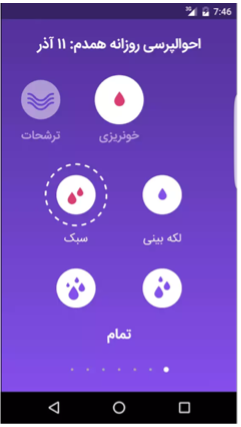
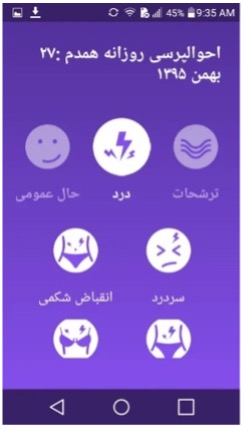

Both examples show how accessibility to information functions to provide knowledge that can enable women to make informed, independent decisions about their bodies. The main difference between the examples outlined in this chapter, and previous examples of Femtech applications, is the shift to a design approach that prioritizes informed consent, transparency and (individual) security.
From this, it can be deduced that in order for Femtech to truly stand as an ally alongside women, the approaches adopted by these apps ought to operate within the Feminist scope. The Feminist Tech Principles, as shown above, provides a solid foundation for this thinking. However, given the nature of the digital space, these principles must remain open to discourse thereby allowing for change and development. In order to achieve this, Feminist-tech must prioritize individual experience, alternative knowledge, and collectivity as a means of gathering the necessary information to build upon these principles.
The conceptual thinking of the Cyberfeminist movement stands as a starting point in this endeavor. Intended to rip open cyberspace, so that it oozes over the wired network of the digital realm, Cyberfeminism is daring in its approach of challenging the power dynamics perpetuated by technology. This approach remains optimistic in its believe that the digital space offers possibilities for a better world. Thus, the ability of technology to reproduce power should be seen as a resource to empower - ultimately by harnessing it in this capacity, it is vital in the pursuit of a Feminist-tech future.
Conclusion
The above highlights how the design of the contraceptive pill and period tracking apps have evolved into a mechanism of control, which stands in contrast to their initial promise of empowerment. The analysis of the design environment of these technologies has revealed a continued system of power and control over the female body, masked under the notions of empowerment and normativity. This thesis argues for a redesign of these technologies that prioritizes the lived experiences of women by focusing on principles of inclusivity, transparency, and independent decision-making to promote a feminist-tech approach. Two examples that adhere to this approach have been outlined. By following these principles, the Femtech industry can break free from exploitative marketing strategies and manipulative design techniques to become a true agent of empowerment for women. The positive examples indicate hope for the future of Femtech, but at the same time demand urgency for real competition to the market leaders, which, as established above, continue down their oppressive path. Ultimately, it can be said that the findings of this thesis discovered the existence of space in the Femtech market, and a heightened need for a feminist-tech approach that can help promote reproductive and sexual health and rights for all women.